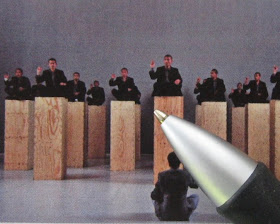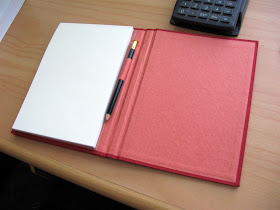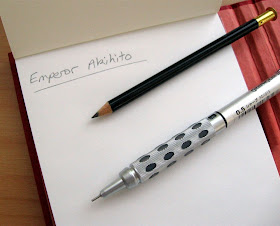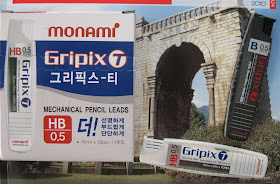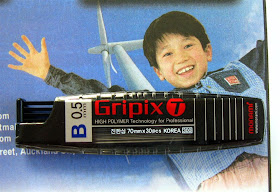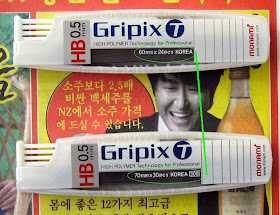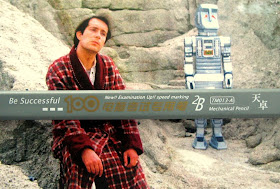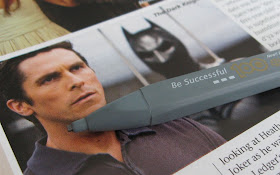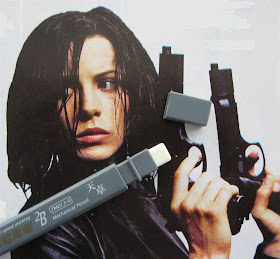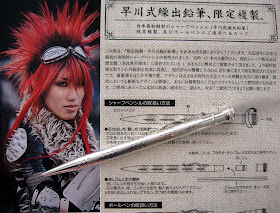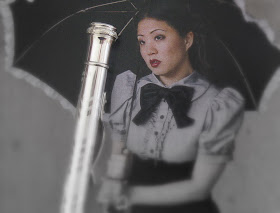I didn't even have to twist his arm!
********
Paper Mate PhD Ultra Mechanical Pencil Review
Major League Baseball teams in the US use traditional wooden bats, but aluminum bats are used in many other levels of baseball as well as the many variations of softball. I am writing this review while watching a community college baseball game. Unlike many [perhaps all] four year college and high school baseball teams, these teams use wooden bats. It would be appropriate, then, to review a traditional wood case pencil. Nonetheless, I will be describing the predominantly plastic Papermate PhD Ultra mechanical pencil. And this pencil may even have some aluminum parts!
The PhD Ultra is a sizable pencil with one of those ubiquitous large twist-to-extend erasers. It is also designed and marketed for its ergonomic semi-triangular finger grip. The body of the pencil is composed of numerous contour curves, bulging along the portion of the body defined by the length of its clip. It narrows down to the contour semi-triangular grip that is the basis for the design of Papermate’s family of PhD writing instruments. The Ultra constitutes one of the newer editions to this product line.
The lead is extended through a retractable conical sleeve, making the instrument pocket-safe. The cone surrounding the sleeve is a metal component shaped like the nosecone of a conventional missile or rocket.
The clip is fabricated of the same non-reflective metal with a smooth finish.
The top two-thirds of the pencil is composed primarily of a highly reflective glossy black plastic with a gray ring design where the clip connects to the body. Although it is a relatively inexpensive pencil, its appearance would make it suitable in a formal office setting. With its metal trim and high-luster plastic, it is one of the more attractive of the many larger and wider pencils with ergonomic grips and twist-to-extend erasers, derived from a variation on a common manufacturing design.
 The grip, itself, comprises a very taut material, stretched across the underlying contoured triangular surface. There is no give in the surface covering and upon initial observation, it might not be immediately obvious that this material is not part of the fundamental structural surface of the pencil. Due to the triangular shape of the grip, the pencil may be rotated in the hand to one of three positions and the fixed clip means that most users would only write with the clip side facing outward. The grip occupies most of the bottom third of the instrument. The rest is occupied by the cone and the retractable tip when it is extended.
The grip, itself, comprises a very taut material, stretched across the underlying contoured triangular surface. There is no give in the surface covering and upon initial observation, it might not be immediately obvious that this material is not part of the fundamental structural surface of the pencil. Due to the triangular shape of the grip, the pencil may be rotated in the hand to one of three positions and the fixed clip means that most users would only write with the clip side facing outward. The grip occupies most of the bottom third of the instrument. The rest is occupied by the cone and the retractable tip when it is extended.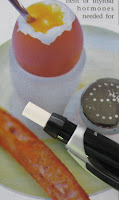 The eraser material is Papermate’s common Tuff-Stuff polymer and the eraser is held in its cylinder at the top by a plastic apparatus with two prongs that squeeze the eraser in a viselike fashion. The “knob” for twisting the cylinder to extract or retract the eraser has a smooth outer surface of glossy plastic like most of the rest of the body of the pencil. This improves the appearance of the eraser unit, but makes it harder to grip.
The eraser material is Papermate’s common Tuff-Stuff polymer and the eraser is held in its cylinder at the top by a plastic apparatus with two prongs that squeeze the eraser in a viselike fashion. The “knob” for twisting the cylinder to extract or retract the eraser has a smooth outer surface of glossy plastic like most of the rest of the body of the pencil. This improves the appearance of the eraser unit, but makes it harder to grip.As in most of these pencils, the pencil point is released by depressing the eraser unit. The initial press releases the conical tube. Subsequent presses release approximately 1 mm of 0.5 mm lead. The writing tip appears to be cushioned because the lead breaks much less frequently than I would expect with a typical 0.5 mm mechanical pencil.
For those who like ergonomic grips and large erasers on their mechanical pencils, I believe that is one of the better examples. The pencil is quite suitable for long periods of general writing. It is probably not as suitable for precise drawing tasks for a variety of reasons, including the bulky cone at the bottom which may result in a more obstructed view than thinner pencils or pencils with transparent materials at the end of the writing instrument.
I’ve had this pencil for almost a year and it appears to be reasonably durable. There is some abrasion on the bottom portion on one side of the grip section. This may have resulted from pressing against a metal key or some other metal object. The abrasion is barely noticeable and has not increased. In addition, some of the writing on the barrel is gradually, but very slowly, wearing off. The internal aperture in the lead cylinder allows for approximately a dozen 0.5 mm leads. However, I have found that a smaller number such as 10 leads prevents occasional jamming. Such jams are rare and the usual lead clearing steps resolve any problem. I enjoy using this pencil and appreciate its outstanding grip, large eraser, and overall appearance.
[Note: I wrote this review in its entirety with my Phd Ultra. I then copied it into Microsoft Word with minor grammatical changes, etc.]
*********
Thanks Bob. I appreciate you accepting the challenge and taking the time to write this review and send it in.
You have no idea how much I want to stick another 'i' in aluminum!
Dave.


